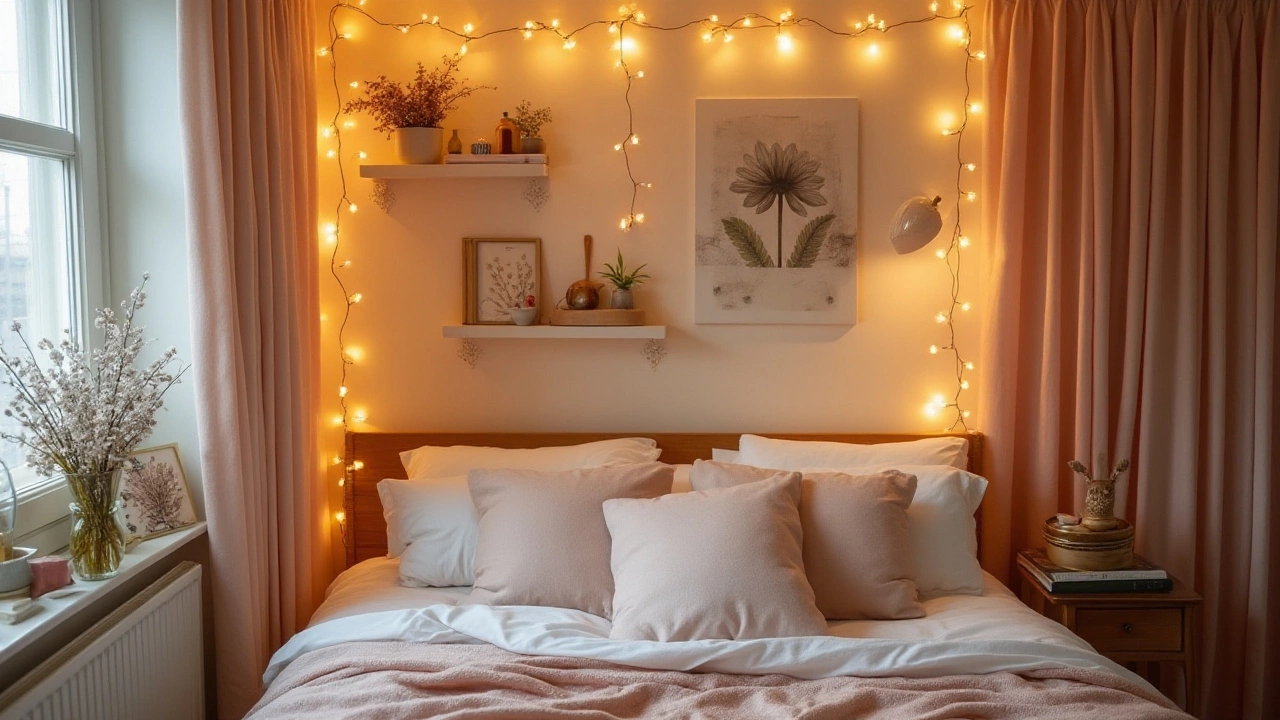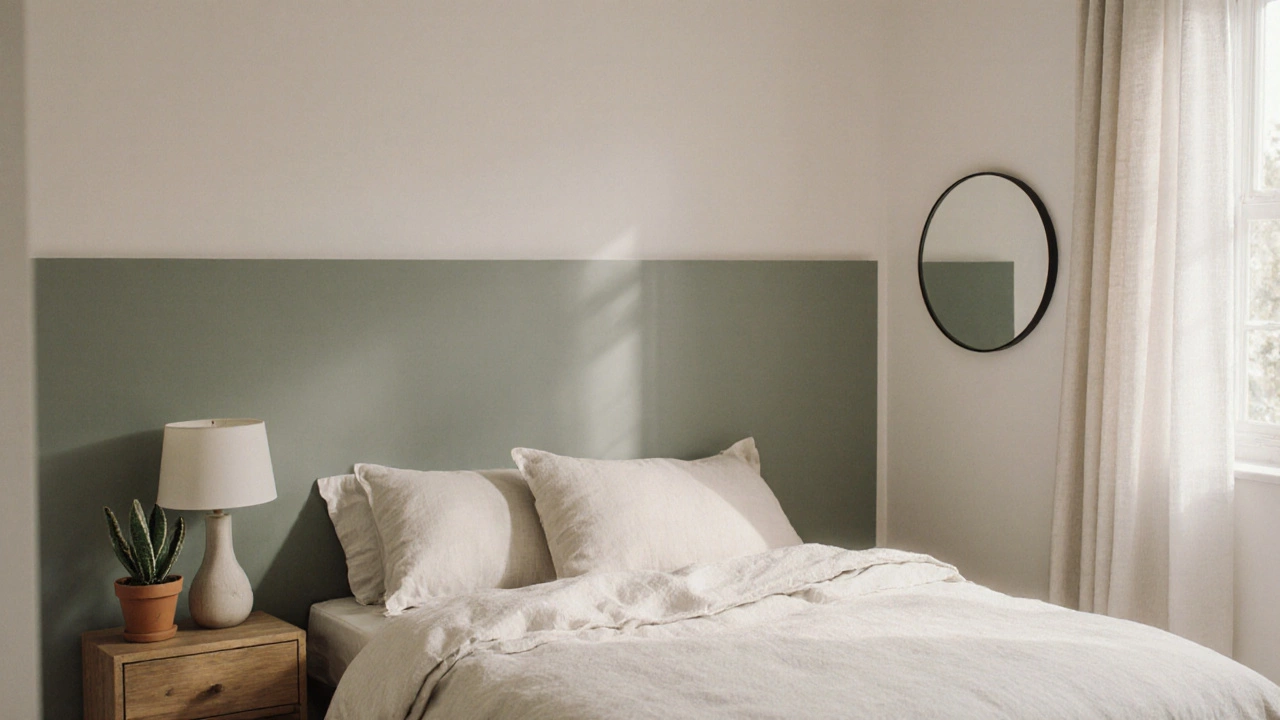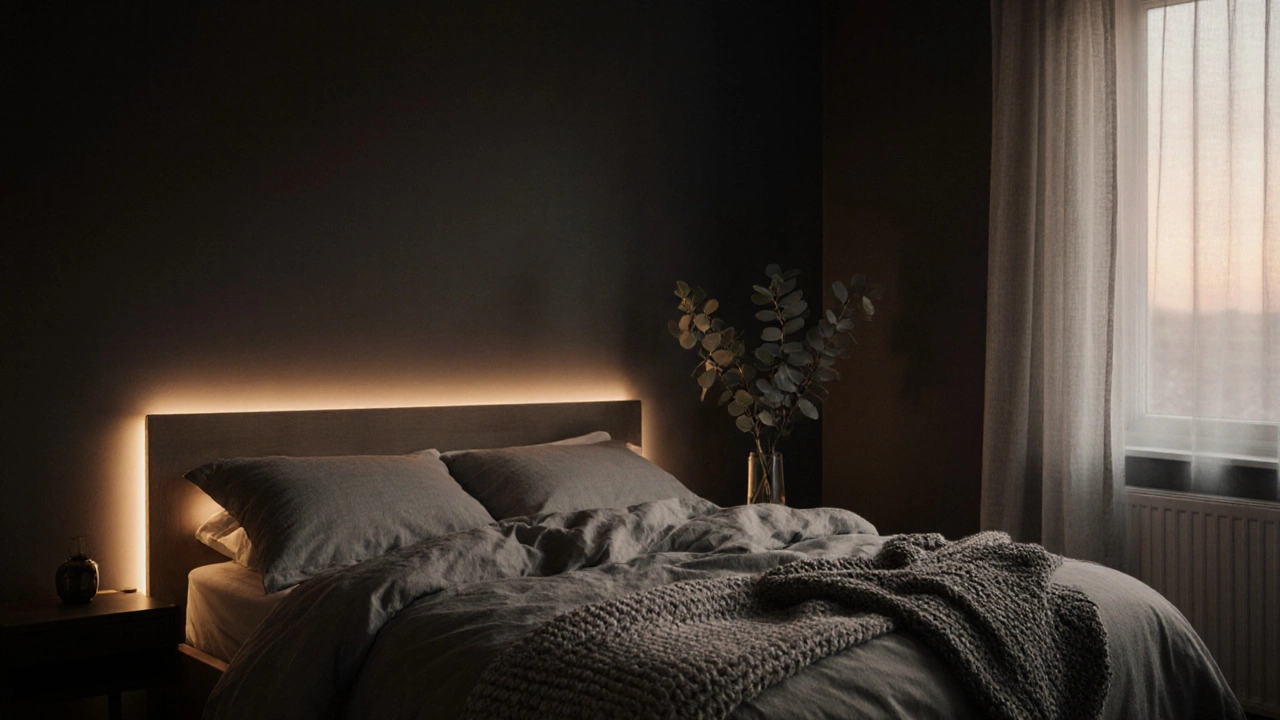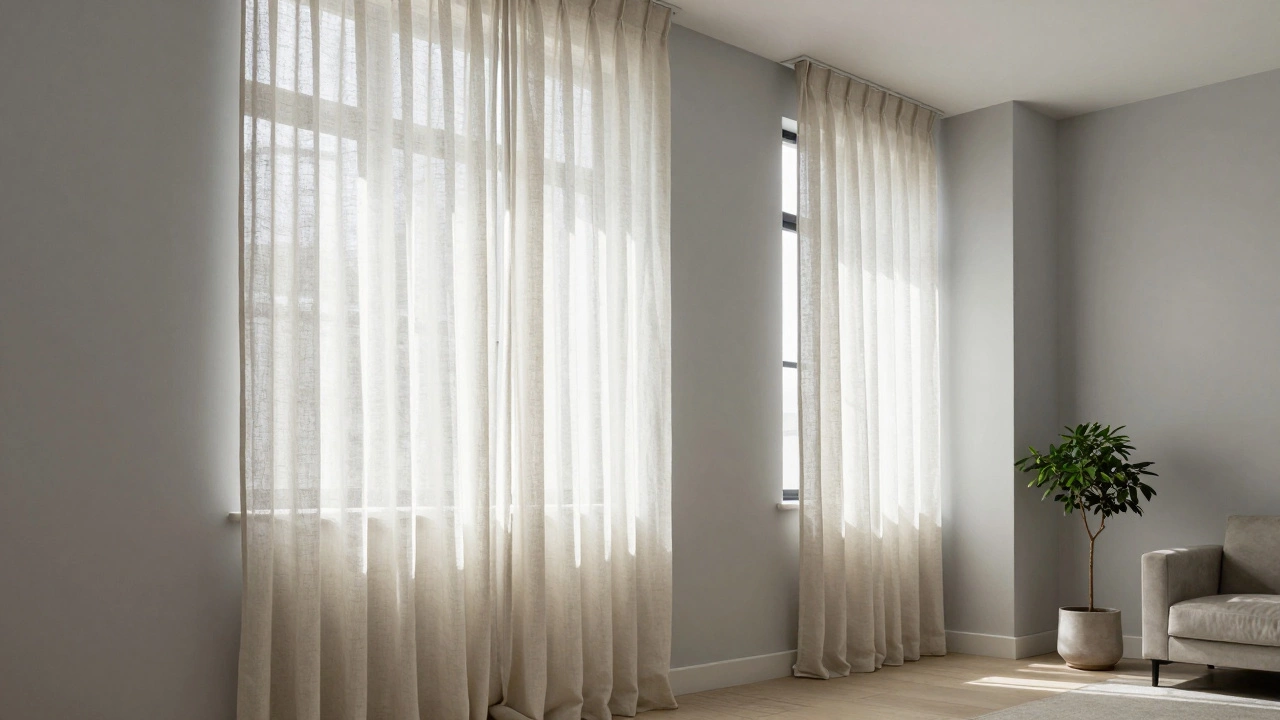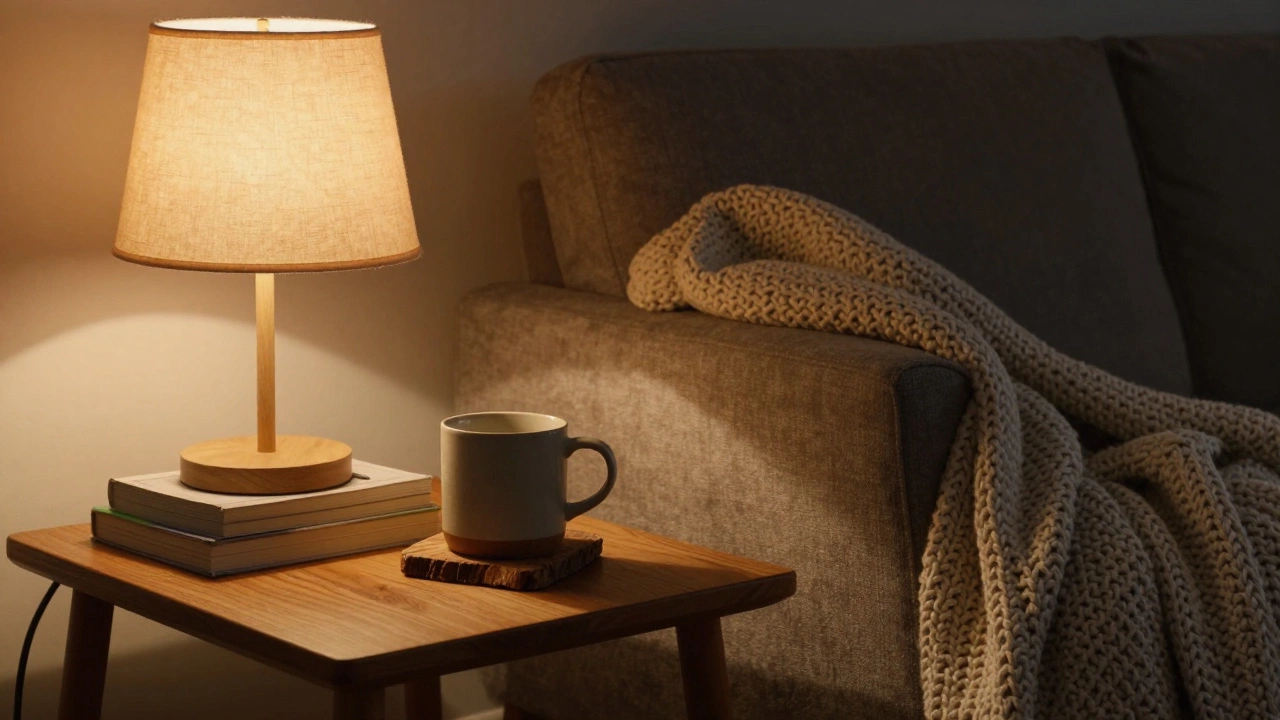Decorating your bedroom wall is like painting the heart of your personal sanctuary, and it doesn't have to be a daunting task. With a bit of creativity and some practical tips, you can transform any bare wall into a striking centerpiece that reflects your taste and comforts your senses.
Think about the wall as a blank canvas. The choices range from selecting the perfect color palette to utilizing textures that compliment your aesthetics. Perhaps it's the charm of rustic wood or the sleek elegance of metal art; every choice says something about you.
Art lovers can explore galleries of framed photos, eclectic art pieces, or even a personal collage to define their space, turning their wall into a gallery of life. Shelves, if chosen wisely, can add both utility and elegance, offering a fresh take on storage and décor.
Lighting, often an overlooked aspect, plays a crucial role in enhancing wall features. The right lighting can add depth and warmth, making your bedtime book nook even more inviting.
No matter your budget, discover numerous DIY ideas that can be both economical and fun. With these strategies, infuse your space with personality without burning a hole in your pocket. Ready to dive into bedroom wall decoration magic? Let's get started.
- Choosing the Right Color Palette
- Exploring Textures and Patterns
- Incorporating Wall Art and Frames
- Tips on Using Shelves Creatively
- Lighting Techniques for Wall Transformation
- DIY and Budget-Friendly Decoration Ideas
Choosing the Right Color Palette
When it comes to bedroom decor, the color palette you choose can have a profound impact on the overall feel and mood of the room. Selecting the right colors is not just about what looks good; it's also about what makes the space feel right for you. The psychological effects of colors should not be underestimated. For instance, blue shades are known for their calming influence, making them a popular choice for creating a peaceful and serene bedroom environment. On the other hand, warm tones like yellows and oranges can introduce a sense of warmth and coziness, perfect for those early morning wake-ups.
Before you land on a color scheme, consider the natural light your bedroom decor receives throughout the day. Natural light can dramatically change how colors appear. South-facing rooms generally benefit from warm colors, while north-facing rooms might shine brightest with cooler tones to bring in some balance. Take some time to observe your room during different times of the day to see how sunlight affects it. This will guide you in choosing colors that will look great and feel good both in daylight and after dusk.
Balancing main colors with accent colors is another layer to the art of color selection. A popular technique is the 60-30-10 rule, where 60 percent of the room is dominated by a primary hue, 30 percent by a secondary color, and 10 percent by a bold accent. This approach gives the room a cohesive look while adding splashes of character without overwhelming the senses. Play around with color swatches at the store or use online visualizers to get a better idea of how certain combinations might work in your space.
Materials and textures can also influence how colors are perceived. Matte finishes generally absorb light and can make bold colors appear more subdued, whereas gloss finishes reflect light, making colors pop. This aspect can be incredibly useful when you want to introduce a bold color in a subtle way. According to the renowned interior designer Abigail Ahern, "Color initiates an emotional chain reaction. It can instill calm and radically transform a room."
Ahern’s philosophy emphasizes the transformational power of color, which, when applied thoughtfully, can breathe life into any room.
For those unsure about committing to a specific color, accent walls offer a great compromise. They allow you to experiment with bold hues without transforming the entire room. Many find success with deep green or navy accents, creating a focal point that adds depth and interest. Look for areas in the room that naturally draw attention, such as the wall behind your bedhead, to apply these colors effectively.
When in doubt, start with a neutral base and layer colors through accessories and furnishings. This method allows for flexibility; you can switch out these elements as your taste evolves. Neutral shades such as shades of grey, beige, and white provide a versatile backdrop that blends well with various styles and color accents, making them a timeless choice for many homeowners. So take your time and don’t rush it. Finding the perfect color palette can be a joyful journey that goes beyond paints and brings peace and personality into your cozy bedroom retreat.
Exploring Textures and Patterns
When it comes to decorating your bedroom, textures and patterns play a powerful role in defining the aesthetic of the space. These elements not only add depth and interest but also evoke different emotional responses. Imagine the cool, smooth feeling of a satin wall contrasted with the rustic, comforting effect of exposed brick. Each texture creates its own unique story and shifting narratives within the confines of your walls. Thanks to technological advances, one can mimic any texture with wallpaper that looks so authentic it could deceive even the keenest eyes.
Choosing the right pattern is equally pivotal. From classic stripes that elongate walls to intricate florals that inject a cozy, cottage-like ambiance, patterns influence the vibe of the bedroom. Geometric designs bring a modern, sophisticated touch and can cleverly alter perceptions of room dimensions. According to a report by Elle Decor, incorporating varied designs keeps spaces intriguing, breaking visual monotony.
"Patterns can transform a cold space into a warm sanctuary, balancing scale and proportion to create harmony," says interior designer Nate Berkus.
To blend textures and patterns seamlessly, it is important to strike a balance. Layering too many can lead to chaos, while too few might make a room seem stark and unfinished. The rule of three is often a good guideline - this refers to integrating no more than three patterns in one room. Focus on one large, dominant pattern and two smaller, complementary ones. For texture, combine opposing elements, like a soft, fluffy throw against a rough, wooden headboard, creating a tapestry that tantalizes both the eye and the hand. If you are hesitant at first, consider starting with smaller accents like a textured cushion or a patterned rug before committing your walls.
A study by the International Journal of Design highlights how tactile interaction with textures can significantly contribute to perceived comfort and satisfaction in interior spaces. Adorn your walls with textiles, art installations, or even living walls that bring vibrant patterns to life. Pay attention to fabric choice, where options range from the understated elegance of linen to luxurious velvet. For an eclectic look, mix materials such as metal alongside natural fibers to bring an unexpected yet harmonious blend.
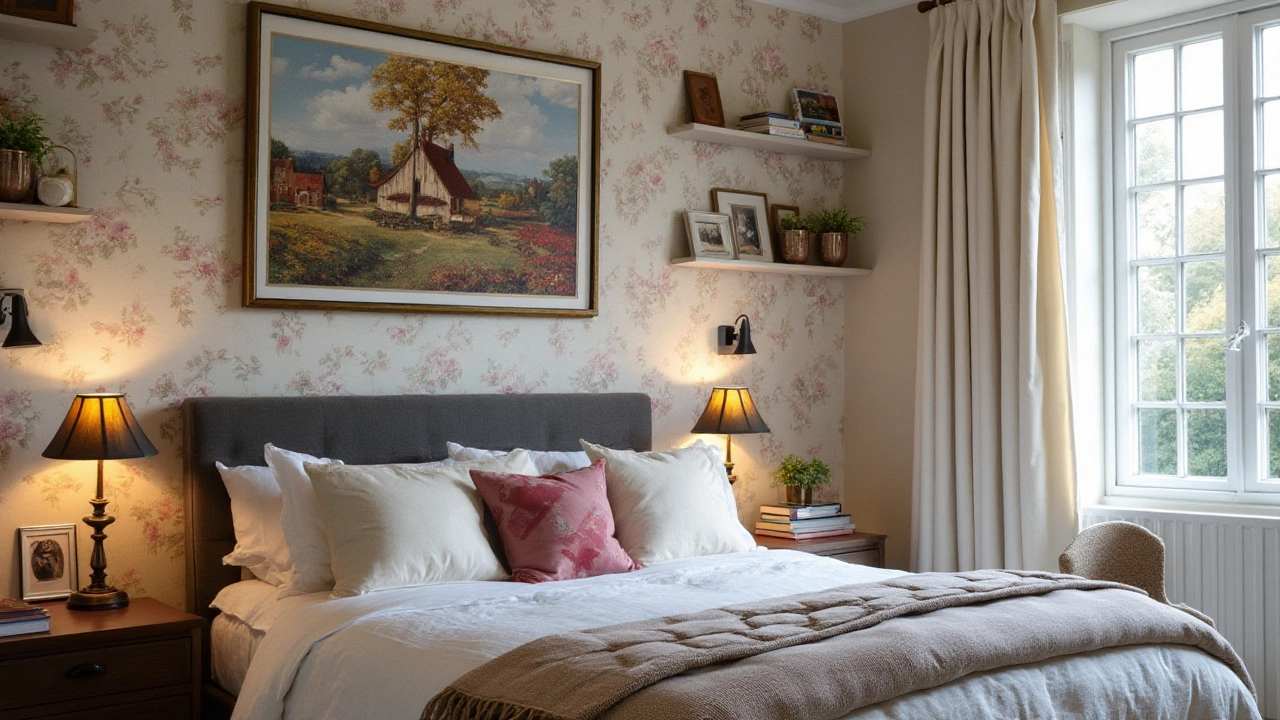
Incorporating Wall Art and Frames
Wall art and frames can be transformative elements in any bedroom decor scheme. They not only offer visual interest and personality but also serve as focal points that can set the mood of the entire space. Picture this: a vibrant painting above a bed, drawing the eye and adding color to a neutral room, or a series of monochrome prints creating a chic, cohesive look. It's not just about hanging a piece of art; it's about telling a story that resonates with you every time you enter the room.
When choosing art for your bedroom walls, think about what appeals to you on a deeper level. Is it landscapes that transport you to your favorite travel destinations, abstracts that spark your imagination, or photographs that capture nostalgic memories? Selecting art with emotional significance can enhance your connection to the space. As art critic Jonathan Jones once stated,
"A room without art is like a body without a soul."Such strong, evocative elements of wall decoration can elicit emotions and memories, enhancing your personal retreat.
Once you have your chosen pieces, consider their arrangement. A single large piece can make a bold statement, aptly filling a space above the headboard, while a gallery wall can offer a dynamic collection that encourages exploration and contemplation. Mixing various frame styles and sizes can add an interesting dimension. Traditional frames bring a sense of order and refinement, whereas frameless mounts or clip frames can give a modern, understated look. Experimenting with layout before hanging can prevent unnecessary holes in the wall; lay pieces out on the floor first or use paper templates to visualize potential arrangements.
The height at which you hang your artwork also matters. Typically, eye level is ideal—this often means the center of the piece should be about 57 to 60 inches from the floor. However, when hung above furniture, ensure it is close enough to form a cohesive group with the furniture below. Think of your wall, artwork, and furniture as an integrated whole. This approach can create a harmonious flow and avoid awkward empty spaces that disrupt the design.
Choosing the right type of frame is as important as the art itself. Materials such as wood bring warmth and a touch of nature into the bedroom, while metal frames can contribute a modern edge. Selecting frames that echo other elements in the room, like furniture finishes or metallic lamp bases, can create a unified look. Don’t shy away from bold colors if you’re aiming for a room with energy and life. But, if tranquility is your goal, soft pastels or deep, rich hues might work best.
If your style leans more towards minimalism or you’re living on a budget, there’s no need to compromise on creativity. DIY art projects can be an incredibly rewarding way to personalize your space. A simple canvas with abstract paint strokes can become a conversation piece. Incorporating textures, like fabrics or mixed media, adds depth and intrigue. Even a collection of beautiful postcards or fabrics can be framed to beautiful effect, offering a cohesive theme.
To summarize, incorporating wall art and frames into your bedroom decor should be more than an afterthought. Be it through selecting pieces that tell your story, carefully planning their arrangement, or even creating your own, every choice contributes to a nurturing and inspiring personal haven. So, dive into the process with enthusiasm, and let your creativity flourish.
Tips on Using Shelves Creatively
When it comes to transforming your bedroom decor, shelves are truly multifunctional wonders. These simple additions can convey style, add character, and bring a sense of organization to what might otherwise seem like chaotic decor. When planning to integrate shelves, start by considering their purpose and placement. For instance, floating shelves can offer an illusion of extra depth, making your room appear larger. They’re perfect for displaying prized collections without taking up floor space, a critical advantage in compact areas.
Color plays an important role, too. Think about matching the shelf color with your wall. By doing this, items on display become the main attraction, while contrasting colors can create visual interest. Items on shelves should resonate with the overall theme of your room, whether that's minimalist, rustic, or contemporary.
Consider mixing and matching different shelf lengths and depths. This brings a dynamic and playful element to the room. You might want to position smaller shelves asymmetrically around a larger piece, such as a portrait or a clock. This variation not only increases storage but also adds to the aesthetic charm.
In the words of renowned interior designer Nate Berkus, "Your home should tell the story of who you are, and be a collection of what you love."
Nate Berkus emphasizes the importance of personal storytelling through design elements, like shelves.By displaying personal items on your shelves, such as travel souvenirs or cherished books, you're transforming your space into a narrative of your journey through life.
If you love greenery, integrate plants into your shelving plans. A touch of nature not only beautifies the space but also purifies the air, offering a refreshing atmosphere. Slim pots or hanging vines can turn ordinary shelves into lively gardens. Organizing these elements may require some experimentation for the right balance.
Creative ideas allow for framed artworks and crafted pieces to share space with everyday items such as lamps or alarm clocks. Varying the height of your shelf contents can break monotony and charm the eyes, leading them to explore each item thoughtfully.
For those who enjoy a touch of resourcefulness, DIY shelves can save big on costs. Upcycled wood pallets or old drawers repurposed into rustic shelves are not only economical but add a unique touch that prefabricated shelves lack.
Here's a look at how you can mix utility with creativity. Establishing shelves near a reading nook serves dual purposes: storing books and showcasing a collection of beloved tales. Or, perhaps in a child's room, shelves can be fashioned into a tiny gallery of stuffed animals and favorite figurines.
| Idea | Room Type |
|---|---|
| Floating Shelves | Modern Bedroom |
| Asymmetrical Layout | Eclectic Design |
| Nature Integration | Eco-Friendly Room |
| DIY Wood Shelves | Rustic Style |
| Symmetrical Bookshelves | Elegant Layout |
So, next time you're thinking of redesigning your living space, remember that shelves are not just for storage; they're for storytelling. Let them speak about your style and add that personal touch to your bedroom, making it a true creative retreat.
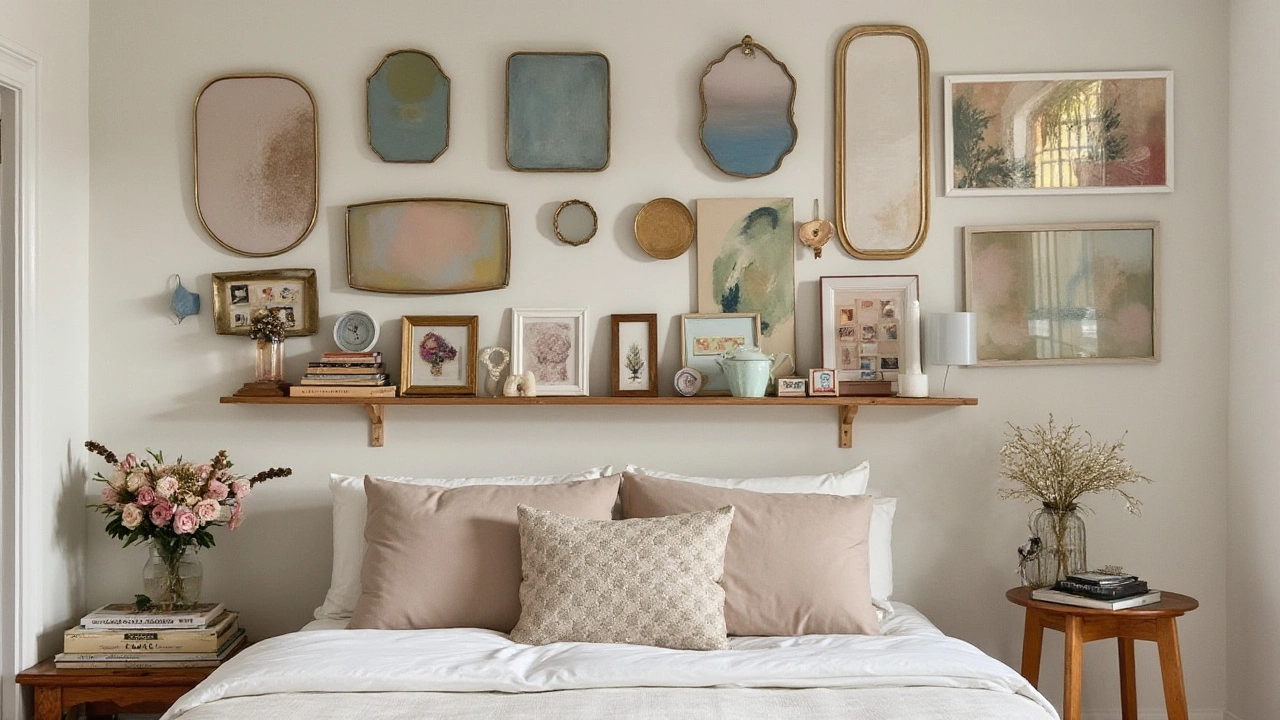
Lighting Techniques for Wall Transformation
Imagine walking into your bedroom, and with a single flick of the switch, your walls come alive, transforming the entire vibe of the room. That's the sheer power of effective lighting. Proper lighting can highlight wall textures or art, making them pop and giving life to even the most minimalist setups. With the right lighting, your bedroom decor can go from dull to dazzling, crafting a mood that is entirely your own.
One popular technique is to use wall sconces. They not only save space but also offer a soft, upward glow that adds a subtle touch of elegance. Place them strategically around artwork or a striking color feature to draw attentions. Another option is installing LED strips around crown moldings or behind furniture. This creates a halo effect, making the walls seem taller and your bedroom more expansive. Dimmers or smart bulbs are also fantastic choices, allowing you to adjust the brightness according to your mood or time of day.
"Lighting is not just about illumination. It is about controlling the mood, enhancing beauty, and adding dimension," says renowned interior designer Nate Berkus.
Spotlights are another valuable tool when you want to emphasize specific areas of your wall. By directing the light beam, you can bring attention to art pieces or architectural details. If your bedroom has a textured wall, such as exposed brick or intricate wallpaper, spotlights can cast dramatic shadows, offering visual interest that evolves throughout the day.
For a soft, romantic glow, fairy lights or string lights can be woven through shelving or draped across the wall. Alternatively, use them to frame a headboard for an intimate yet playful ambiance. Not only is this setup inexpensive, but it can also be easily changed, allowing you to update your bedroom decor frequently.
Beyond these traditional methods, consider natural light, which can vastly influence wall perception. Mirrors positioned to reflect sunlight can brighten up dark corners and invite a natural, airy feel into the space. Embrace these techniques, and watch as your bedroom walls transform from mere partitions to essential elements of personal expression.
DIY and Budget-Friendly Decoration Ideas
Revamping your bedroom decor doesn't need to break the bank; in fact, some of the most personal and cherished pieces are those created by your own hands. Embracing DIY projects not only allows for a deep personal touch in your bedroom space but also comes with the satisfaction of having crafted something truly unique. Start with some old jars or bottles, which, when painted or wrapped with twine, can double as rustic vases or charming storage. It is all about reimagining everyday items into beautiful décor elements that reflect your personal style and bring character to your cozy bedroom.
An effective way to add character to a wall is by creating a framed gallery. Gather a mix of your favorite photographs, art prints, or even pages from old books. Arrange them in an asymmetrical pattern for a contemporary look, or stick to a grid for something more traditional. Don't throw away those leftover wallpaper scraps from past projects! Cut them into shapes to make an intriguing wall patchwork that stands out. This method not only costs little but also adds vibrancy to the bedroom wall with pops of color and pattern.
Ever thought a simple string light could vastly enhance a room's ambiance? Draping string lights or fairy lights creates a soft, inviting glow and can be an easy fix for a gloomy dark corner. It transforms the ambiance and highlights artistic elements on your walls. According to renowned interior designer Jane C. Smith, "Lighting is not just illuminating the space; it's about setting a mood and creating an environment."
For those who love greenery, bringing in a few small plants in wall-mounted planters can breathe life into your room. Use lightweight plant holders to display herbs or succulents, an addition that creates visual interest and ensures fresh air. Try crafting your planters out of recycled materials like plastic bottles or old tin cans, experimenting with shapes, sizes, and colors that match your bedroom's theme.
For more minimalist accents, consider simple wall hangings made from locally sourced materials. A piece of driftwood can become the perfect hanger for threads, beads, or even feathers, adding layers of texture to your bedroom's backdrop. It’s not just about decoration—it's about telling a story with the pieces you choose to display.
To complete the upgrade, make use of fabric remnants to create a tapestry or wall hanging. Gather various pieces from old clothing or linens. Stitch them together, or simply hang them with pins to provide warmth and texture. This textile artwork lends a comfortable layer of softness to your bedroom wall, often becoming a focal point of admiration and storytelling.

